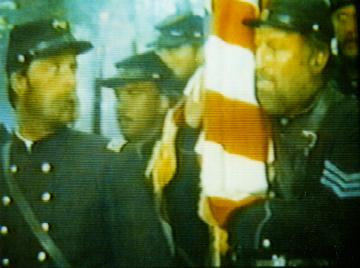
Rank, duty position and unit at time of action:
Sergeant, Company I, 20th Maine Infantry Regiment, V Corps, Army of the Potomac
War:
Civil War
Place and date of action:
Little Round Top, Gettysburg, Pennsylvania, 2 July 1863
Portrayed by:

In the film:
TOZIER, ANDREW J.
Rank and organization: Sergeant, Company I, 20th Maine Infantry. Place and date: At Gettysburg, Pa., 2 July 1863. Entered service at: Plymouth, Maine. Birth: Monmouth, Maine. Date of issue: 13 August 1898. Citation: At the crisis of the engagement this soldier, a color bearer, stood alone in an advanced position, the regiment having been borne back, and defended his colors with musket and ammunition picked up at his feet.
Like his commanding officer, Colonel Joshua Lawrence Chamberlain, Andrew Tozier would receive his nation's highest military award for valor at Little Round Top, but would also have to wait over three decades for the honor.
Assigned to hold the extreme left flank of the Army of the Potomac at Gettysburg with an understrength regiment of 386 men, the 20th Maine under Chamberlain successfully repulsed six assaults by a Confederate brigade through a series of unconventional, creative maneuvers. When the 20th Maine ran low on ammunition, Chamberlain desperately led, with more unconventional maneuvering, a preemptive bayonet counterattack, capturing over 400 prisoners and driving the remainder of the Confederate brigade into headlong retreat. As the regimental color bearer and the regiment's most visible member, Tozier undoubtedly had even more shots fired at him than Chamberlain himself, in one of the most intense engagements within the largest and bloodiest battle in American military history.
Chamberlain, a professor of rhetoric before the war, later described Tozier's actions much more vividly than the rather dry citation text above: "I saw through a sudden rift in the thick smoke our colors standing alone. I first thought some optical illusion imposed upon me. But as forms emerged through the drifting smoke, the truth came to view. The cross-fire had cut keenly; the center had been almost shot away; only two of the color guard had been left, and they fighting to fill the whole space; and in the center, wreathed in battle smoke, stood the Color-Sergeant, Andrew Tozier. His color staff planted in the ground at his side, the upper part clasped in his elbow, so holding the flag upright, with musket and cartridges seized from the fallen comrade at his side he was defending his sacred trust in the manner of the songs of chivalry."
In The Twentieth Maine: A Volunteer Regiment in the Civil War, John J. Pullen further describes the heroic stand of Tozier and the color guard as "a grouping that could have been a model for the sort of heroic statuary that came out of the war to adorn village squares." [Unfortunately, through an apparent oversight, Mr. Pullen omitted Tozier from the list in his book of Medal of Honor recipients who served with the 20th Maine, and the authors are grateful to a visitor to this website for bringing Tozier's eligibility for an entry on this website to our attention. Despite this oversight, we continue to join the rest of the military historian community in holding up Mr. Pullen's work as one of the best unit histories ever written.]
Little is known about Tozier, but it is indicated that, at 25, he was a much younger man at the time of the action than as portrayed by Herb Mitchell in Gettysburg. There are indications that he was a veteran of the 2nd Maine prior to transfer to the 20th. He may, in fact, have been one of the 120 men who had been involuntarily transferred to the 20th when the 2nd was disbanded, having enlisted for three years while the majority of the 2nd Maine had enlisted for two; they were originally considered mutineers and delivered to the 20th Maine as prisoners but were persuaded by Chamberlain to integrate into the ranks of the 20th. [One of the few instances of dramatic license exercised by historical novelist Michael Shaara (in the original novel The Killer Angels) and screenwriter Ronald F. Maxwell was in having the situation occur on the march to Gettysburg two days before the battle, whereas it actually occurred some six weeks earlier in mid-May 1863.] If this is indeed the case, it is an irony that Tozier's first appearance in the film is as an original member of the 20th, directed by Chamberlain to guide the former 2nd Maine soldiers to the mess area.
In the film, Tozier was a relatively minor character in
contrast to Chamberlain being one of the two primary Union Army
protagonists. That does not diminish the key role he played in
real life in braving the intense gunfire to anchor the position
of the 20th Maine as they stood their ground, and in leading the
way during the counterattack.
At least three other men who received the Medal of Honor for
action at Gettysburg (all during the defense of Cemetery Ridge
against Pickett's Charge on the third and last day of the
battle) were given cameo appearances in the film: Brigadier
General Alexander Stewart Webb, commanding general of the
Philadelphia Brigade (2nd Brigade, 2nd Division, II Corps),
played by historical consultant Brian Pohanka; and 1st
Lieutenant Alonzo Hersford Cushing and 1st Sergeant Frederick
Fuger, respectively the commanding officer and first sergeant of
Battery A, 4th US Artillery, played by uncredited reenactors.
For details on their citations, please follow the link to the US
Army Center of Military History website on the Bibliography page.